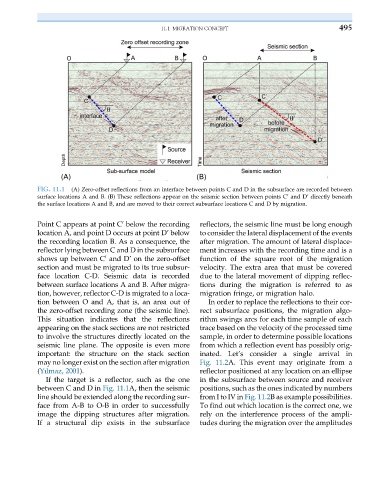Page 504 - Acquisition and Processing of Marine Seismic Data
P. 504
11.1 MIGRATION CONCEPT 495
FIG. 11.1 (A) Zero-offset reflections from an interface between points C and D in the subsurface are recorded between
surface locations A and B. (B) These reflections appear on the seismic section between points C and D’ directly beneath
0
the surface locations A and B, and are moved to their correct subsurface locations C and D by migration.
Point C appears at point C below the recording reflectors, the seismic line must be long enough
0
location A, and point D occurs at point D’ below to consider the lateral displacement of the events
the recording location B. As a consequence, the after migration. The amount of lateral displace-
reflector lying between C and D in the subsurface ment increases with the recording time and is a
shows up between C and D’ on the zero-offset function of the square root of the migration
0
section and must be migrated to its true subsur- velocity. The extra area that must be covered
face location C-D. Seismic data is recorded due to the lateral movement of dipping reflec-
between surface locations A and B. After migra- tions during the migration is referred to as
tion, however, reflector C-D is migrated to a loca- migration fringe, or migration halo.
tion between O and A, that is, an area out of In order to replace the reflections to their cor-
the zero-offset recording zone (the seismic line). rect subsurface positions, the migration algo-
This situation indicates that the reflections rithm swings arcs for each time sample of each
appearing on the stack sections are not restricted trace based on the velocity of the processed time
to involve the structures directly located on the sample, in order to determine possible locations
seismic line plane. The opposite is even more from which a reflection event has possibly orig-
important: the structure on the stack section inated. Let’s consider a single arrival in
may no longer exist on the section after migration Fig. 11.2A. This event may originate from a
(Yılmaz, 2001). reflector positioned at any location on an ellipse
If the target is a reflector, such as the one in the subsurface between source and receiver
between C and D in Fig. 11.1A, then the seismic positions, such as the ones indicated by numbers
line should be extended along the recording sur- from I to IV in Fig. 11.2B as example possibilities.
face from A-B to O-B in order to successfully To find out which location is the correct one, we
image the dipping structures after migration. rely on the interference process of the ampli-
If a structural dip exists in the subsurface tudes during the migration over the amplitudes

